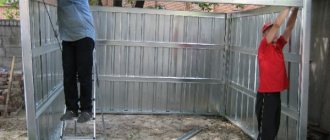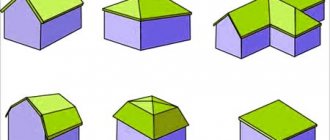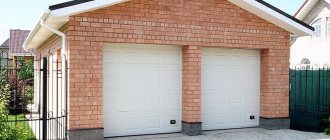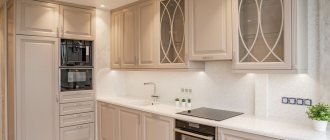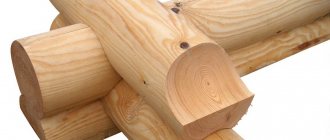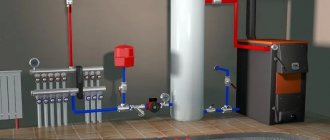Read in the article:
- Warm monolith
- Most active
- Natural Balance
- PKB - the same wood, only warm
- First certified
- Exactly according to the rules
- Based on a standard project
Just a few years ago, when they were just starting to talk about technologies for building an energy-efficient house, many developers perceived it as something completely fantastic. Build a passive house in Russia? Skeptics spoke about the conservatism of domestic builders and the untested technology. And the brave and progressive moved energy-efficient construction forward
Today in Russia, not only individual houses are being built, but also entire villages of energy-efficient cottages. Before giving examples of completed projects, we suggest remembering how it all began. The technology for constructing passive buildings came to us from Germany. But a passive house (German: Passivhaus) is not just a new modern technology. In Germany, a voluntary standard (Passivhaus Standard) has been developed, which defines the requirements for the design and construction of such facilities. The Passivhaus Institute is promoting this technology and adapting it to Russian conditions, which helps domestic builders master Passivhaus in practice.
Before starting to understand the technology itself, it was necessary to overcome the resulting confusion in terms. How to call such houses: passive, energy-passive, conditionally passive, energy efficient? Today we have decided on the terminology. Let us recall that the main criterion for assessing a passive house is the specific consumption of thermal energy for heating during the heating period, calculated per year. According to this standard indicator, according to the classification adopted in Europe, houses with low (36–50 kWh/m²) and ultra-low heat consumption (16–35 kWh/m²), passive (15 kWh/m²), and also with zero energy consumption and positive energy balance.
At first, some domestic development companies, realizing the promise of energy-efficient construction, rushed to call their new facilities passive. But actually it is not
None of the houses built in Russia using Passivhaus technology is pure Passivhaus. For one simple reason - the indicators indicated above have not been achieved. In order for such houses to be considered passive, the value of the standard indicator should be reconsidered taking into account Russian climatic conditions, which are more severe than European ones. After all, even if we strictly observe all the features of passive house technology, we are unlikely to be able to achieve a value of 15 kWh/m².
Specialists from the Passivhaus Institute, trying to still follow German standards, explained that objects built in Russia using Passivhaus technology should be called houses with low or ultra-low heat consumption. However, in practice these terms have not taken root. And today the term “energy efficient” is used in everyday life. If we summarize everything that has been written about an energy efficient home (EEH), we can say that it is a broader concept that denotes a tendency to save resources consumed by a building. Energy-efficient houses can be built using various technologies, but the main principle of designing such objects will inevitably be the use of all possibilities for storing heat in them in order to minimize energy costs. Now let’s look at the features of some energy-efficient private house projects implemented in Russia.
Warm monolith
The authors of the house project based on permanent formwork are confident that this technology is quite suitable not only for individual, but also for standard construction. Let's look at how the criteria for an energy efficient home (EH) were implemented by them in practice.
Since thermal insulation plays a special role in this project, an insulated monolithic reinforced concrete slab was chosen as the basis of the house. To prevent the formation of cold bridges, the base and blind area (its width is 1–1.2 m) were insulated along the contour of the building with slabs of foamed polystyrene foam. For the construction of the walls, permanent formwork technology was used. Its main structural elements are lightweight polystyrene foam blocks. They are mounted one on top of the other, and they close together tightly, without gaps. Reinforcement is placed horizontally and vertically into the internal cavities of the blocks, and then concreting is carried out. The house frame created using this technology is durable and has a short construction time.
The best construction technologies
The best construction technology is the construction of a frame base, which does not require additional waste and insulation measures. The basis is a reliable block of polystyrene permanent formwork connected by jumpers. To prevent the room from blowing in and to retain heat in winter, a layer of sound insulation is added to the floor.
The construction of brick housing is carried out using the laying of supporting and finishing bricks and insulation. Such a building has an increased heat capacity. It can be heated in a few hours, and the room temperature remains the same throughout the night. The technology does not use mineral wool, which does not allow moisture to pass through well, is susceptible to destruction, and creates a greenhouse effect.
In order to comply with the standards for supplying heat to a residential building when designing, it is necessary to study Federal Law No. 261-FZ. A cold, drafty building wastes a lot of fuel. Therefore, heating becomes expensive for owners and also depletes national resources.
Property information
Object: residential building with a total area of 246 m²
Design and construction:
Materials and equipment: permanent formwork, reinforcement, concrete, Neopor polystyrene foam, waterproofing, energy-efficient windows and doors, Zehnder recuperator (Germany), Nibe heat pump (Sweden)
House box cost: RUB 25,000/m²
The wall “pie” of the house is a multi-layer structure (from the inside out): a layer of expanded polystyrene 50 mm thick, supporting a frame made of monolithic reinforced concrete, a layer of expanded polystyrene (100 mm) and 150 mm of energy-efficient polystyrene foam “Neopor”, covered with facade plaster
The house has windows with wooden frames and thermal insulation liners made of polyurethane foam. Double-chamber double-glazed windows are filled with argon, and a selective heat-reflecting transparent coating is applied to the surface of the outer and inner glass. The window frames are separated from the concrete enclosing structures by a layer of expanded polystyrene (permanent formwork), and on the outside they are adjacent to a layer of “Neopor”, which almost completely eliminates the possibility of cold bridges.
In energy-efficient homes, heating and ventilation systems are closely related to each other. This facility uses a supply and exhaust ventilation system with heat recovery. The recuperator, in combination with a horizontally buried ground heat exchanger, works both for air heating and cooling (in the hot season).
Calculations of energy consumption at home were carried out by German specialists. Thus, the calculated specific energy consumption for heating was 24 kWh/m² per year. If we compare this with the cost of heating a city apartment, then the cost per 1 m² of space in the city is 8 times higher. Experience in operating an energy-efficient monolithic house has shown that all expectations for heat savings were fully justified.
2
Installation and replacement of pumps
One of the main activities of our company is the replacement and installation of water pumps of all types: surface, submersible and semi-submersible. The company’s specialists with extensive experience will install, dismantle and install the following pumping equipment in the shortest possible time:
- borehole pumps;
- well pumps;
- water pumps;
- circulation pumps;
- booster pumps;
- irrigation pumps.
In addition to installing and replacing pumps, we also carry out work on complex pumping stations, carrying out complex operations for installation, dismantling and installation of equipment.
Sources
- https://sdelat-dom.ru/remont/otoplenie/otoplenie-chastnogo-doma/
- https://cotlix.com/otoplenie-v-chastnom-dome-svoimi-rukami-podrobnoe-rukovodstvo
- https://sovet-ingenera.com/otoplenie/razvodka-o/razvodka-otopleniya-v-chastnom-dome.html
- https://master-houses.ru/shemy-otopleniya-dlya-chastnogo-doma-kakie-luchshe/
- https://oboiman.ru/teplo/sistemy-otoplenia-castnogo-doma-svoimi-rukami-shemy-razvodki.html
- https://otivent.com/kak-sdelat-otoplenie-chastnogo-doma-ili-kvartiry
- https://www.tproekt.com/razvodka-otoplenia-v-castnom-dome-svoimi-rukami/
[collapse]
Most active
This facility stands apart among the energy-efficient houses built in our country and is a test and exemplary building not only in the Moscow region, but throughout Russia. The Active House philosophy is based on three key principles: energy saving, a healthy microclimate and respect for nature. Like Passive House, the Active House concept was developed in Europe. However, this project was initially adapted to the conditions of central Russia. The terms of reference for the design of the Active House defined energy saving requirements that were unprecedented for the Moscow region - three times higher than the normative ones. More precisely, the heat transfer resistance of walls is increased by almost 4 times, the basement floor by 3.3 times, the pitched roof by 3 times, and the windows by 2.8 times.
Heat consumption for ventilation
To find out how much heat a private house loses as a whole, you need to add up the losses of all its rooms. But that’s not all, because we must also take into account the heating of the ventilation air, which is also provided by the heating system. In order not to go into the jungle of complex calculations, it is proposed to find out this heat consumption using a simple formula:
Qair = cm (tв – tн), where:
- Qair – required amount of heat for ventilation, W;
- m – amount of air by mass, defined as the internal volume of the building multiplied by the density of the air mixture, kg;
- (tв – tн) – as in the previous formula;
- с – heat capacity of air masses, is taken equal to 0.28 W / (kg ºС).
To determine the heat demand for the entire building, it remains to add the value of QTP for the house as a whole with the value of Qair. The boiler power is taken with a reserve for the optimal operating mode, that is, with a coefficient of 1.3. Here you need to take into account an important point: if you plan to use a heat generator not only for heating, but also for heating water for domestic hot water supply, then the power reserve must be increased. The boiler must operate effectively in 2 directions at once, and therefore the safety factor must be taken at least 1.5.
Property information
Total area:
230 m²
Organizers:
COUNTRY PROJECT and VELUX
Architects:
experimental laboratory POLYGON
Detailed design of wooden structures:
"NLK Domostroenie"
Scientific support and testing:
"PASSIVE HOUSE INSTITUTE" (Russia)
Materials:
wooden structures (NLK Domostroenie), insulation "Framework P-32" (ISOVER), vapor barrier Delta-Reflex (DÖRKEN), wind insulation, polymer PVC membrane Monarplan FM (ICOPAL), heat-treated board, windows and solar collectors VELUX, thermal DANFOSS pump, GAULHOFER vertical windows, SOMFY and DECOR-CITY sun protection, WINDOWMASTER smart home system, ZEHNDER GROUP hybrid ventilation system, SCHIEDEL chimney
Energy efficiency indicators have been improved due to high-quality and most reliable insulation, and the use of renewable energy sources helps to significantly reduce energy consumption
Section of an “active house”
In architectural terms, the building has a solid volume and a set of protruding elements (porch, balcony, mezzanine, chimney). The house is oriented west - east and has an offset slope facing south, thanks to which the solar collectors installed in the roof can be used as efficiently as possible. All living spaces face south, the glazing area is increased both due to vertical and attic windows. The southern facade can rightfully be called an “active facade”, because it itself is rebuilt depending on weather conditions and the needs of the inhabitants of the house. Automatic sun shading systems open, increasing surface illumination and heating of rooms using solar energy, and close, preventing overheating on hot days.
The building is built on a pile foundation with a grillage, and the walls are based on a frame made of laminated coniferous wood. One of the secrets to the energy efficiency of a home lies in the features of the “pie” of the wall. The thickness of the frame is three times larger than usual - 550 mm, excluding layers of internal and external finishing. It is designed to minimize heat loss and ensure the tightness and rigidity of the building. The walls are a load-bearing wooden frame lattice structure with thermally insulated voids. Twelve layers of Isover “Frame P-32” slab insulation, which has the lowest thermal conductivity coefficient (and is specially designed for frame houses), make it possible to achieve the thermal protection indicators specified by the project. The floors and roofing also have an increased thickness of thermal insulation: 650 mm for the basement, 240 mm for the interfloor and 600 mm for the roof.
The use of a geothermal heat pump for heating has reduced energy costs and reduced the negative impact on the environment. The use of solar collectors in parallel with this pump makes heating, cooling and hot water supply to the home even more efficient and economical.
3
Boiler connection
It should be noted that the wiring of gas, diesel and electric heat generators is almost the same. Here we must take into account that the vast majority of wall-mounted boilers are equipped with a built-in circulation pump, and many models are equipped with an expansion tank. First, let's look at the connection diagram for a simple gas or diesel unit:
The figure shows a diagram of a closed system with a membrane expansion tank and forced circulation. This tying method is the most common. The pump with a bypass line and a sump tank is located on the return line, and there is also an expansion tank there. The pressure is controlled using pressure gauges, and air is removed from the boiler circuit through an automatic air vent.
Note. Piping an electric boiler that is not equipped with a pump is carried out according to the same principle.
When the heat generator is equipped with its own pump, as well as a circuit for heating water for domestic hot water needs, the pipe layout and installation of elements is as follows:
Shown here is a wall-mounted boiler with forced air injection into a closed combustion chamber. To remove flue gases, a double-walled coaxial flue is used, which is led out horizontally through the wall. If the firebox of the unit is open, then you need a traditional chimney with good natural draft. How to properly install a chimney pipe made of sandwich modules is shown in the figure:
In country houses with a large area, it is often necessary to connect a boiler with several heating circuits - a radiator, heated floors and an indirect heating boiler for DHW needs. In such a situation, the optimal solution would be to use a hydraulic separator. It will allow you to organize independent circulation of coolant in the boiler circuit and at the same time serve as a distribution comb for the remaining branches. Then the basic heating diagram for a two-story house will look like this:
According to this scheme, each heating circuit has its own pump, thanks to which it operates independently of the others. Since coolant with a temperature of no more than 45 ° C should be supplied to heated floors, three-way valves are used on these branches. They add hot water from the main line when the temperature of the coolant in the heated floor circuits drops.
With solid fuel heat generators the situation is more complicated. Their strapping should take into account 2 points:
- possible overheating due to the inertia of the unit; the firewood cannot be extinguished quickly;
- formation of condensation when cold water enters the boiler tank from the network.
To avoid overheating and possible boiling, the circulation pump is always placed on the return side, and on the supply side there should be a safety group located immediately behind the heat generator. It consists of three elements: a pressure gauge, an automatic air vent and a safety valve. The presence of the latter is crucial; it is the valve that will relieve excess pressure when the coolant overheats. If you decide to heat your house with wood, then the following wiring diagram is required:
Here, a bypass and a three-way valve protect the furnace of the unit from condensation. The valve will not allow water from the system into the small circuit until the temperature in it reaches 55 °C. Detailed information on this issue can be obtained by watching the video:
Advice. Due to the nature of their operation, solid fuel boilers are recommended to be used in conjunction with a buffer tank - a heat accumulator, as shown in the diagram:
Many homeowners install two different heat sources in the furnace room. They must be properly tied and connected to the system. For this case, we offer 2 schemes, one of them is for a solid fuel and an electric boiler working together with radiator heating.
The second scheme combines a gas and wood heat generator, supplying heat to heat the house and prepare water for hot water supply:
Natural Balance
Some ED pilot projects were accused of the fact that their architecture was far from Russian traditions. ROCKWOOL decided to prove that energy-efficient construction is cost-effective and can also be applied to traditional buildings. The Natural Balance country cottage was built in just six months. This is a one-story house with a residential attic, intended for one family.
The basis of the house is a strip monolithic foundation. The 0.5 m high plinth is a three-layer brick structure with a middle layer of insulation. Thermal insulation thickness is 150 mm. The floors of the first floor are also insulated. The walls of the building are constructed from aerated concrete blocks. The facade was made ventilated in accordance with the project.
What to build a house from to live in winter?
Cottages built of wood and brick can be considered the warmest. The remaining materials have a lot of advantages and, most importantly, allow you to build a house much faster and cheaper, but they can cause inconvenience to the owner in the winter.
To prevent this from happening, it is important to follow the recommendations of experts:
- observe the presence of deformations of the external and internal finishing;
- avoid moisture getting inside the walls;
- do not turn off the heating in winter;
- timely treat walls with special means and replace insulation.
If these conditions are met, frame and block houses will also delight you with warmth and comfort in winter for many years.
Did you find this article helpful? Please share it on social networks: Don't forget to bookmark the Nedvio website. We talk about construction, renovation, and country real estate in an interesting, useful and understandable way.
Property information
Total area: 186 m²
Energy efficiency class: A
Reduced energy consumption by 78.5% compared to a building of the same area built using traditional technology
Thermal resistance indicators:
Rfoundation = 3.6 m²°C/W, Rwalls = 5.2 m²°C/W
Rroof = 6.1 m²°C/W, Rwindows = 0.79 m²°C/W
Various types of thermal insulation are used in house designs. This is explained by the fact that specialized material has higher technical characteristics than universal
Ventilated façade design
This facility has energy-saving windows with a five-chamber profile 76 mm thick. Double-glazed windows are filled with inert gas, and the inner glass has a low-emissivity coating. When designing the building, we used the principles of “solar” architecture: most of the windows are oriented to the south.
Heating and hot water supply is provided by a geothermal pump. Taking heat from the ground for its own heating, the house uses it very wisely. Instead of traditional radiators, a low-temperature water heated floor system was installed in the rooms. Although the use of energy-efficient technologies increased the cost of construction by 22%, this is not too high a price to pay for living comfortably in a warm, environmentally friendly house and annually saving more than 22,000 rubles on heating and hot water supply.
The external walls were built from aerated concrete blocks, the façade was made ventilated
The house is heated using underfloor heating
Heating and hot water supply is provided by a geothermal pump
4
If the house is cold, it needs to be insulated
It is not always possible to make a house warm during the construction phase. There may be design errors, changes in operating conditions, requirements for the building by the owners, and much more. The problem of additional home insulation is especially relevant for those homeowners who purchased a ready-made house on the secondary market. It is simply impossible to obtain objective information about how warm the premises are in winter until you spend the winter there yourself.
Insulation of the house
If the problem has become obvious, you can make the house warm with your own hands. To do this, you need to determine what the house is built from, what type of insulation is best, and how to install it correctly. And then the matter remains small.
PKB - the same wood, only warm
Implemented projects of energy-efficient wooden houses have also appeared. As you know, any building made of solid wood does not meet the requirements for energy efficiency of buildings contained in SNiP 02/23/2003. The solution to the problem was a modern material that combines all the inherent advantages of wood and complies with standards for thermal resistance - passive laminated veneer lumber (PKB). This is a profiled laminated timber with effective insulation (CARBON XPS). It is glued inside the lamellas, and additional stiffening ribs are not used to prevent cold bridges from appearing. The efficiency of PCB with a cross-section of 200 × 180 mm compared to laminated veneer lumber of the same cross-section in terms of heat saving is 10 times higher.
Liquid fuel boilers
In terms of the cost of heating equipment and its installation, heating with waste oil or diesel fuel will cost approximately the same as with natural gas. Their efficiency indicators are also similar, although the processing, for obvious reasons, is somewhat inferior. Another thing is that this type of heating can easily be called the dirtiest. Any visit to the boiler room will end with at least the smell of diesel fuel or dirty hands. And the annual cleaning of the unit is a whole event, after which you will be smeared with soot up to your waist.
Using diesel fuel for heating is not the most profitable solution; the price of fuel can hit your pocket hard. Used oil has also risen in price, unless you have some cheap source. This means that it makes sense to install a diesel boiler when there are no other energy sources or, in the future, a main gas supply. The unit easily switches from diesel fuel to gas, but the exhaust furnace will not be able to burn methane.
Property information
Object: residential building with a total area of 650 m²
Design and construction: JSC Green Wood House
Materials and equipment: screw piles, PCB timber, holofiber insulation, steam and waterproofing, bitumen shingles, energy-efficient windows and doors, recuperator, heat pump, solar collectors
Total cost of the house: 17,000,000 rubles.
Total cost of equipment: heat pump, solar collector (three panels), supply and exhaust ventilation with heat recovery, storage tank, Astra-8 septic tank, components, air ducts and fittings, heat exchangers - RUB 1,271,052.
Since PCB is lightweight, buildings made from it do not require a strong foundation. The house we want to talk about used a foundation on screw piles
Assembling a cottage box has its own characteristics. It is performed without “corners”, using a technology called “City corner”. Its essence is as follows: the walls of the house frame are connected to each other by sawing the ends of the beams at 45°, and the partitions are sawed into the walls without outlets to the outside. The advantages of such a corner connection are the absence of cold bridges in the corners of the building due to a continuous layer of insulation and significant savings on materials (10–15%). Holofiber, a modern thermal insulation material made of polyester, based on fibers in the form of a spiral spring, was used as inter-crown insulation.
What makes a home energy efficient? First of all, the absence of cold bridges and a sealed thermal circuit, which is created thanks to effective insulation materials located inside the timber, between the crowns and in other structural elements of the building. The heat transfer resistance of a 200 mm thick PCB wall, according to the test protocol carried out by certified bodies, is 5.9 m² ° C/W. This is a very high figure - almost twice as high as required by SNiPs for central Russia.
The second component is energy-efficient windows and doors. In this case, windows were installed with a heat transfer resistance of 1.6 m² °C/W and doors with a heat transfer resistance of 1.8 m² °C/W. The translucent structures installed in the house are distinguished by an innovative approach to their manufacture: a specially designed thermal chamber using new insulation and sealing materials reduces heat loss and eliminates the formation of cold bridges. The width of the window frame is 200–250 mm. It adapts to the thickness of the walls of the house, so no additional elements are required on the inside or outside. Hidden fittings allow you to create a two-frame structure without reducing the light opening.
The third mandatory element of a passive house is supply and exhaust ventilation with heat recovery. A 12 kW geothermal heat pump is used to heat the premises. The heating system also includes vacuum solar collectors (SC), which are also used for the cottage’s hot water supply. This became possible due to the installation of a water heated floor system. It is combined with a heat pump and solar collectors, which further increases its efficiency by 15%.
Warm corner made using City Corner technology
Creating a laminated timber frame
5
How to choose a heating unit
Factors influencing the choice of a boiler (or several water heating devices):
- energy carrier used;
- heat generator power;
- dependence on external energy sources;
- price;
- functionality, ease of use.
Note. The heater selection criteria are arranged in order of priority. It is important for the user that the unit consumes cheap fuel and produces enough heat. Price plays a secondary role; comfort and functionality come in third place.
All household boilers are usually divided into groups according to the type of fuel (energy carrier) burned:
- gas;
- electrical;
- solid fuel;
- liquid fuel, consuming diesel fuel and waste oil;
- universal, operating on 2-3 types of energy carriers.
Each of the listed groups is divided into varieties according to the operating principle, installation method and other criteria. We will review existing boilers and give a number of useful recommendations.
Types of gas boilers
To organize heating in private homes, 3 types of units using natural gas are sold:
- Atmospheric. The combustion chamber is open, combustion air is taken from the boiler room. The operating efficiency is in the range of 86...88%.
- Supercharged (aka turbocharged). Air is forced into the closed firebox by a fan controlled by an electronic circuit. Boiler efficiency is 90...93%.
- Condensation. Structurally similar to turbocharged heaters, but the heat exchanger and burner are designed in such a way that in a certain mode the boiler uses the latent heat of combustion of the fuel. Efficiency – 95%.
Reference. All heat generators are capable of burning 2 types of fuel - natural gas and liquefied propane-butane mixture (LPG). To switch to LPG, the fuel jets are replaced and the automation is adjusted.
Boilers are manufactured in wall, floor and parapet versions. The first group is ready-made mini-boiler rooms, equipped with their own expansion tank and pump. The second type is high-power units, or those that do not depend on electricity. Parapet models are placed near the outer wall, the chimney goes directly to the street.
Among the large assortment of gas water heaters, it is not easy to make the right choice. Our recommendations are:
- If you are on a limited budget, purchase an atmospheric wall-mounted boiler. But remember - open-chamber heaters require a traditional chimney.
- To work together with the gravity system, you will need a non-volatile floor-mounted atmospheric unit.
Floor-mounted non-volatile heater equipped with a single-stage burner, mechanical automatic safety system EuroSIT and a cast iron heat exchanger
- It is better to install a forced-air heat generator in an apartment or cottage without a ready-made chimney. Organize the removal of combustion products through a coaxial pipe laid through the outer wall.
- To supply hot water to 1-2 consumers, buy a dual-circuit model. If the consumption in the DHW network is high, you will need an indirect heating boiler connected to a conventional single-circuit heater.
- Read the detailed description of all gas heaters presented in a separate article.
A condensing boiler is the most economical among gas-using devices. The disadvantage of the unit is the complexity, high price of the equipment and its repair.
Electric hot water installations
A feature of electric boilers of any type is their high efficiency, reaching 99%. The second positive point is the low installation costs and purchase of the heaters themselves. The units should be used as auxiliary heat sources, operating at night at half the light tariff.
There are 3 types of electric boilers (all are available in wall-mounted versions):
- With traditional tubular heaters - heating elements. Modern devices are equipped with an expansion tank and a circulation pump.
- Electrode. Heating of the coolant occurs due to a chemical reaction resulting from the passage of current through the water layer between the 2 electrodes.
- Induction. Here the coolant is heated by the steel core of a sealed coil, which creates eddy currents in it.
Heat generator with tubular heaters (TEN) in section
To install electric heating, it is better to take a classic heating element boiler, which does not require serious wiring. The device is reliable and easy to repair - you can always replace a burnt heating element yourself. An induction heat generator is expensive and cannot be repaired in the event of a breakdown, and an electrode heat generator is highly dependent on the salt content in the coolant.
Advice. Don't listen to salespeople who call induction boilers energy-saving. All electrical installations heat water equally efficiently - losses do not exceed 2%, the rest of the energy is converted into heat.
Classification of solid fuel boilers
For heating country cottages, 3 types of solid fuel units are used:
- direct combustion - atmospheric and turbocharged;
- pyrolysis;
- automatic pellet and coal.
There are many myths about the efficiency of TT boilers. Manufacturers of pyrolysis heat generators claim an efficiency of 85-86%, pellet heat generators - up to 90%. In reality, the figures are much more modest: traditional wood-burning units - 75%, pyrolysis units - 75%, boilers using pellets and coal chips - up to 86%.
Construction of a direct combustion boiler with a fire tube heat exchanger
Reference. In addition to the listed types of heaters, there are long-burning TT boilers with an increased size of the firebox. How to distinguish such installations from classic wood-burning heat generators, read the corresponding publication.
Recommendations for choosing a solid fuel boiler:
- A steel direct combustion apparatus equipped with a chain draft regulator is perfect for burning wood, coal and briquettes. Turbocharged examples are automated and burn wood better, but rely on electricity.
- Pay attention to the volume of the firebox of a traditional boiler - the duration of combustion depends on this indicator.
- Automated pellet units are a good solution for lovers of comfortable heating. You don’t have to chop and carry wood, remove coal dust, just clean the firebox and burner weekly.
- Do not mess with pyrolysis TT boilers, they are a priori more expensive than conventional ones, demanding on the quality of fuel, and in addition they consume electricity.
- Avoid models with water-filled grates if you plan to burn with coal. The temperature difference forms a hard crust on the surface of the grate, which is not easy to knock off.
Grate of a TT boiler made of pipes filled with coolant
When choosing a heat generator, remember the old saying “the miser pays twice.” It is better to take a high-quality classic device with a cast-iron heat exchanger than a cheap “pellet generator” with electronics of unknown origin.
Diesel and combined models
This heating equipment is used much less frequently than gas, wood and electric boilers. Diesel fuel is more expensive than other energy sources, and waste oil is a specific fuel that is clearly unsuitable for the average homeowner. Accordingly, such heating devices are operated only in certain conditions when access to other resources is limited.
Multi-fuel boilers from different manufacturers combine 2-3 energy sources, for example, wood + electricity, gas + coal. Advantage: you buy one heat generator and get two. Disadvantage: the unit cannot boast of high efficiency and functionality. The most popular option is shown in the photo - a TT boiler, equipped with a heating element unit for electrically heating water after the flame in the firebox has died out.
Electric wood heater from the Russian company Teplodar
Heat generator power calculation
To select a boiler based on performance, you should find out the load on the heating system of the house. That is, calculate the heat losses of the building. We propose to calculate this indicator in a simplified way:
- If a living room is separated from the street by one wall with 1 window opening, then 0.1 kW of heat is consumed to heat a square meter of area.
- A room with two external walls (corner) and 1 window – 0.12 kW/m².
- The same, with 2 light openings - 0.13 kW/m².
An important nuance. The calculation is performed for each room separately, then the results are summed up.
The algorithm is suitable for buildings with floor heights up to 3 meters. If the ceilings are higher, heat consumption is calculated based on the volume of the room. Accordingly, in a room with 1 fence and a window, the volume value is 35 W/m³, in a corner room – 40 W/m³, in a corner room with two openings – 45 W/m³.
Having determined the need for thermal energy at home, we select the power of the boiler installation according to the instructions:
- The performance of a unit operating only for heating is taken with a margin of 20%. That is, we multiply the found amount of heat by a factor of 1.2.
- The heat generator providing hot water supply must be taken with a reserve of 50% (coefficient 1.5).
- For TT boilers, the increasing coefficients are 1.5 and 2, respectively.
If you live in an area with a mild southern climate, then the coefficients should not be used. Conversely, residents of the northern regions should increase the initial heat loss figure by 1.5-2 times.
Calculation of heat losses by volume of residential premises
First certified
As already mentioned, there are no special materials from which only an ED can be built. Here, for example, is an example of fast, high-quality and economical energy-efficient construction of a frame building. The creators of the project were faced with the task of building a house with a specific annual energy consumption for heating of no more than 50 kWh/m². The basis of this object was a spatial frame made of dried laminated wood. It is designed in such a way as to minimize heat loss, ensure structural rigidity and eliminate cold bridges. Its peculiarity (in contrast to the standard “framework”) is that the wall does not have wooden posts passing through the entire contour. The total thickness of thermal insulation in the walls is 358 mm. To insulate all the main structural elements, fiberglass-based mineral wool “ISOVER Karkas-P-32” was used, which has a low thermal conductivity coefficient λB = 0.03 W/m °C and was developed specifically for frame houses in the Moscow region.
Features of modern insulation
You can make your home warmer yourself using roll or panel insulation. They are mounted on a vertical or horizontal grille, on a plate-shaped dowel-umbrella. Some types of materials are applied using sprayers or expensive construction equipment.
You can choose the type of insulation by studying its characteristics. In modern construction, exterior wall decoration is carried out with the following materials:
- Mineral insulation is an environmentally friendly and non-flammable material that is suitable for finishing any surface;
- Polystyrene or polystyrene foam is an economical material, suitable for insulating brick and aerated concrete surfaces, has a high degree of flammability;
- Eco-wool is a fire-resistant and environmentally friendly material, applied by spraying;
- Polyurethane foam - suitable for additional insulation of a wooden building, processing its frame and cracks, resistant to steam penetration;
- Ceramic insulation - applied by painting or spraying, creates 1-5 mm of unbreakable film.
Ceramic insulation is suitable for owners of designer buildings with uneven walls, broken lines, and spherical elements.
Property information
Object: two-story residential building with a total area of 162.5 m²
Organizers: DPK "Trekhrechye"
Detailed design of the building frame: NLK Domostroenie
Scientific support and testing: Passive House Institute LLC (Russia)
Materials and engineering systems: wooden structures (“NLK Domostroenie”), thermal insulation “ISOVER Frame-P-32” (Saint-Gobain CIS group), steam and windproof films SOLITEX UD/MENTO, Intello+ and SOLITEX WA “PLASTEX” , windows - REHAU (profile), Glass Europe and Glass Team (glazed unit), supply and exhaust ventilation system with heat recovery ZEHNDER, chimney SCHIEDEL, vacuum solar collectors "ATMOSPHERE"
Cost of the object: 10,002,400 rubles.
Thanks to the design features, heat losses are minimized. The heat transfer resistance indicator is: Rroof - 12.8 m² °C/W, Rwall - 8.7 m² °C/W, Rfloor - 8.9 m² °C/W
Ventilation scheme with heat recovery
Special energy-saving double-glazed windows using two Planibel Top N+ low-emissivity glasses, meeting the requirements of certified passive house analogues, were used as translucent elements.
For this facility, we chose a Zehnder Comfosystems ventilation system with heat and humidity recovery from ZEHNDER (Germany). The joint operation of the ventilation unit and the geothermal heat exchanger ensures an actual efficiency of 88% based on monitoring results. For hot water supply to the house, vacuum solar collectors installed on the roof are used.
As for heating, since main gas is not supplied to the facility, after comparing the costs of using various heating sources, we settled on low-temperature electric convectors with thermostats. In any standard home this would be too expensive, but not in an energy efficient one. According to the certificate of compliance of the property with the criteria of an ultra-low energy house, issued by Passive House Institute LLC, the building will consume less than 35 kWh/m² per year.
Frame made of wooden beams
Spatial frame made of laminated wood
Fiberglass-based mineral wool was used for thermal insulation of all structural elements
Geneo window profiles
6
Electric boilers
It must be said that electric heating is the most efficient of all existing ones. Not only are the efficiency of boilers about 99%, but in addition they do not require chimneys or ventilation. There is practically no maintenance of the units as such, except for cleaning once every 2-3 years. And most importantly: equipment and installation are very cheap, and the degree of automation can be any. The boiler simply does not need your attention.
No matter how pleasant the advantages of an electric boiler are, the main disadvantage is just as significant - the price of electricity. Even if you use a multi-tariff electricity meter, you will not be able to beat a wood-burning heat generator in terms of this indicator. This is the price to pay for comfort, reliability and high efficiency. Well, the second disadvantage is the lack of the necessary electrical power on the supply networks. Such an annoying nuisance can immediately cancel out all thoughts about electric heating.
Exactly according to the rules
This object is an excellent example for those who want to understand what an energy-efficient house is. The building was designed and constructed according to all the features of Passivhaus technology. A powerful monolithic reinforced concrete slab with a reverse grillage ensures uniform distribution of the load on the base of the house, the mass of which, taking into account monolithic columns, walls, cladding and snow loads, is about 1000 tons. The walls are made of solid ceramic bricks of grade M250. The thickness of the masonry is 400 mm.
Choosing a coolant
It is well known that filtered and, if possible, desalted water is most often used for this purpose. But under certain conditions, for example, periodic heating, water can freeze and destroy the system. Then the latter is filled with a non-freezing liquid - antifreeze. But you should take into account the properties of this liquid and do not forget to remove all regular rubber gaskets from the system. Antifreeze quickly causes them to become limp and leaks occur.
Attention! Not every boiler can work with non-freezing liquid, which is shown in its technical data sheet. This must be checked when purchasing it.
As a rule, the system is filled with coolant directly from the water supply through a make-up valve and a check valve. During the filling process, air is removed from it through automatic air vents and manual Mayevsky taps. In a closed circuit, pressure is monitored using a pressure gauge. Usually when cold it is in the range of 1.2-1.5 Bar, and during operation it does not exceed 3 Bar. In an open circuit, it is necessary to monitor the water level in the tank and turn off the replenishment when it flows out of the overflow pipe.
Antifreeze is pumped into a closed heating system using a special manual or automatic pump equipped with a pressure gauge. To ensure that the process is not interrupted, the liquid must be prepared in advance in a container of appropriate capacity, from where it must be pumped into the pipeline network. Filling an open system is easier: antifreeze can simply be poured or pumped into the expansion tank.
Property information
Object: residential building with a total area of 379.3 m² in the Wright Park cottage village
Design and construction:
Materials and equipment: reinforcement, concrete, waterproofing, solid ceramic brick grade 250, Neopor insulation (BASF), FOAMGLAS® foam glass blocks, Schöck Isokorb® elements, CREATON ceramic tiles, NELISSEN hand-molded bricks, VIKING windows and doors, heat-treated board
Let us dwell on two important points that are necessary components of the Passivhaus technology and require strict adherence during the construction process. The first is a powerful continuous thermal insulation circuit of the building. To create it, it is not enough to use a calculated layer of effective insulation. First of all, you should get rid of cold bridges at the junction points. This problem is usually solved using the “perforation” method (due to local cold bridges). But in houses built using Passivhaus technology, this technique negates the positive effect of high-quality wall insulation. We have to completely abandon balconies and other architectural details that extend beyond the thermal contour of the building. Therefore, an alternative solution was developed for passive houses - load-bearing thermal insulation elements Schöck Isokorb®. At this site they were installed along the perimeter of the first floor floor slab. They perceive and transmit acting loads to it, while thermally cutting off protruding parts from the thermal contour of the house.
The second important point that needs to be discussed is the use of FOAMGLAS® foam glass insulation. It was placed in one of the most problematic places in the structure of a brick house - at the junction of the foundation and wall masonry. Here, at the base of the wall, a cold bridge is formed, leading to its waterlogging. The solution to the problem is the technology of closing the thermal circuit of the building, that is, connecting the external thermal insulation with the thermal insulation of the floor or ceiling. Traditional insulation is not suitable for this purpose. The best option is foam glass, an incompressible material that does not shrink under constant load and does not change its geometric dimensions. Neopor polystyrene foam boards were used to insulate the walls and ceilings.
All window structures and balcony doors in the house consist of wooden frames with energy-saving inserts and double-glazed windows with hard selective coating and argon filling
I would like to draw your attention to an important feature of window installation. They were installed not directly into the opening of a brick load-bearing wall, but into a wooden box protruding from the opening. This makes it possible to install windows with the required position relative to the dew point. In addition, the protruding frame of the box allows Neopor boards to be tightly fitted to it to ensure a tight joint.
And finally, a few words about engineering communications. The building is heated using a highly efficient VIESSMANN condensing gas boiler and REHAU hydronic underfloor heating. To control the temperature and humidity conditions in the room, a supply and exhaust ventilation unit with heat recovery, Komfovent REGO 1200 HW, is used. The operation of boiler equipment, timely switching on and off of heated floors, heating and fresh air supply are controlled by devices of an intelligent control system certified according to the pan-European KNX/EIB standard.
7
Beam system
The collector (radiant) heating scheme is the most advanced and modern in terms of thermal efficiency. In it, each of the radiators is connected to a pair of pipes from two common collectors for the floor, which are themselves connected to the boiler equipment. Temperature control with this wiring is more flexible. Plus, it is permissible to connect not only batteries to the collectors, but also a “warm floor”.
Among the advantages of such a heating system for a private house, the following should be noted:
- Convenient and flexible adjustment;
- High efficiency of thermal energy distribution;
- Possibility of replacing individual elements without turning off the heating as a whole.
In this case, the pipelines can be laid as desired. Often they are simply laid under the poured floor. The main disadvantage of the beam scheme is the high cost of the system as a whole and the long length of the pipes. Plus, it will be difficult to lay the latter in large quantities in an already finished cottage. Their installation should be planned in advance at the stage of designing a home.
Radial design - ideal heat distribution
This slate, if necessary, can be relatively easily replaced with another roofing material. The layout of the heating pipes is more complicated; changing it later is not so easy. Even the rigid dimensions of the ondulin sheet are not so scary; there are a lot of scraps, but this is only a slight increase in the roof estimate. With heating pipelines, especially for radial distribution, everything is much more complicated.
Liquid polyurethane foam
Application of liquid polyurethane foam
This material is produced using two components: a polyol and a polyisocyanate. The release of carbon dioxide during their interaction makes it possible to obtain surfaces with a foam structure.
Polyurethane foam is available in two modifications:
- with closed voids: has better strength and heat-insulating characteristics, but removes moisture from the walls worse; it, like slab polyurethane, is best used for insulating foundations
- with open voids: widely used for finishing walls, roofs, attics, especially inclined structures
Liquid polyurethane foam is more expensive than penoizol, but has better technical characteristics. It is more durable and elastic, absorbs less moisture. According to manufacturers, this heat insulator, subject to application technology and proper operation, can last up to 50 years.
The disadvantages of liquid polyurethane foam include poor resistance to ultraviolet radiation - surfaces filled with it cannot be left open for a long time. It also does not adhere well to cold walls, so it is necessary to work with it only at positive temperatures. Just like sheet polyurethane foam, the material is flammable and therefore requires additional protection.
Thermal insulating materials for roofing
As you know, warm air tends only upward. If the roof covering is not insulated enough, it will go away unhindered, and the house will quickly dry out. If up to 15-20% of the heat evaporates through the walls, then about 10-20% escapes through the roof. This fact should not be neglected.
Thermal insulation of the roof with polyurethane foam
For thermal insulation of roofs, any types of materials can be used, from mineral wool to slag or sawdust. When using expanded clay, it is most often mixed with foam granules - this helps reduce the weight of the insulation and enhance its effect.
Rolled eco-, glass, mineral wool, as well as liquid polyurethane foam are used mainly for inclined surfaces. Rigid slabs and bulk insulation are used for laying on floor slabs.
Thermal insulation of the roof must be thought out even before laying the structure - after all, when using heavy backfill materials, the load on the foundation will increase significantly.
When can you start insulating a building?
There is a basic rule in construction - it is necessary to begin finishing work on buildings after the house has completely settled. This may take about a year. Moreover, shrinkage occurs not only in wooden houses, but also in brick, monolithic frame buildings, etc.
Installation of thermal insulation is preferably carried out in dry weather - the house is well dried beforehand. The house should already have a roof, external waterproofing of the foundation, ventilation, windows, doors.
All work on finishing a log house begins only after it has settled
You should not start work either in frost or heat - you must wait until the temperature reaches above zero of 5-25°C. The optimal time to start finishing the facade is late spring or early autumn.
Penoizol
Liquid carbamide foam plastic (penoizol) is convenient because it can be poured directly at a construction site. It perfectly fills all irregularities and voids without expanding in volume. However, it is possible to obtain a high-quality coating without cracks only at temperatures up to +5°C.
Working in the cold with it is strictly prohibited.
Carbamide foam is also produced in the form of slabs or crumbs, called thermal wool, blown into hollow frames. The absence of seams is the most important advantage of the material. It is used to insulate walls, attics, roof spaces or as a layer in brick walls.
Thermal insulation with foam insulation
In terms of service life, it exceeds conventional foam plastic or extruded polystyrene foam - the service life can be up to 80 years. Builders often complain about its low strength, but this is due to the use of penoizol of insufficient density. The improved material is not inferior in strength to flexible and dense polystyrene foam.
The porous structure of carbamide foam allows for good vapor removal. However, due to its ability to absorb liquid, it requires moisture protection. Not only film followed by finishing with durable panels, but also cement-sand plaster can serve as waterproofing.

